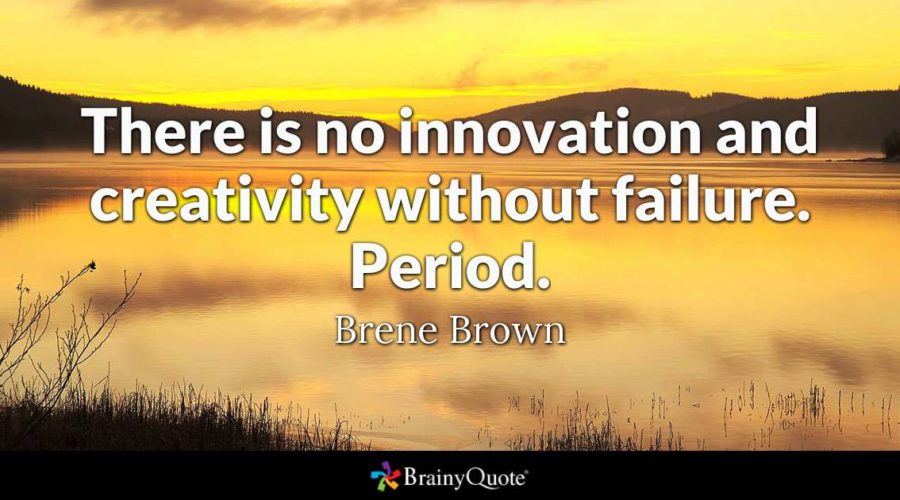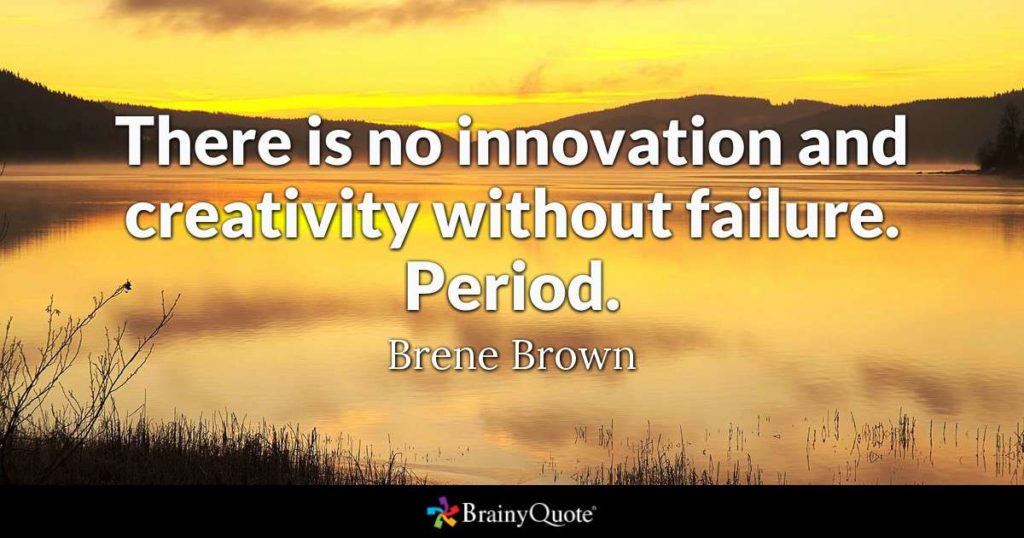Teaching Failure
Failure is not something that anyone likes. It’s so hard to put your all into something and then have it go wrong or fall apart. But, failure is a part of life. You are not going to be 100% perfect all the time at everything you do. We are humans, not robots. I truly believe the quote above: from Brene Brown: “There is no innovation and creativity without failure. Period.” Failure teaches us that we need to reflect on what has happened, and go back and rework. Thus, we get innovation and hopefully, in the process creativity as well.
I believe that many students (and adults) struggle with failure. Maybe there is huge pressure to succeed from their family, some are perfectionists, and there are a crop of other reasons that students break down or shut down when they fail.
I think we can show our students that it is okay to fail, and then dust yourself off, and try again. We can do this by trying new things. Try new lessons, or new ways to teach something you’ve always taught. How about incorporating a new piece of technology? I think we worry that if it doesn’t all go right, then we are failing our students. This is a great opportunity to show our students how to keep cool under pressure when something doesn’t go as planned. To persevere. To be flexible. And to try again. If a piece of technology doesn’t work right, chances are a student in your classroom (or your librarian) knows how to fix it. Ask for help! By modeling all this behavior, you are teaching students that it is okay to fail and then how to react to the failure and keep going.
I have been thinking about failure a lot recently as I recently did an Introduction to Poetry Breakout room with a freshman English teacher. I have completed many Breakout rooms within the last two years and they have all been successful. So, I guess it was time for one to go awry. This was also only my second Breakout room I’ve done to introduce a topic.
I will admit that my normal style for Breakout rooms is to collaborate with the content teacher -they bring the content and I bring the puzzles- and we either create a Breakout room from scratch or we take one from the Breakout EDU site and change it up to fit our students better. For this one, I purchased an escape room from TeachersPayTeachers (again, not my norm). I am not in any way knocking this escape room, but it was built to be an escape room without the BreakOut EDU kits, so no locks, no boxes, etc. I reworked it so that I could incorporate a couple of locks and boxes so students would still have that element (they really like the locks and boxes).
But, I was confident that there would be at least one group that would Breakout. Though it was an introduction to poetry Breakout, I knew they had a background in poetry from middle and elementary school. They also had a figurative language cheat sheet to remind them what each type of figurative language was.
The first period who did the escape room never got past the second challenge (out of four) and then I started to get really worried. But, we decided not to make any changes until the other two classes had a crack at it. The other two classes did much better, although no groups broke out that day. Side note: we did have the groups pick up where they left off the next day and several groups did complete the tasks and breakout.
At the end of the day, the English teacher and I that worked on this Breakout room together sat down and reflected. I will admit, I was super bummed. So was she. We were so confused as to why all the groups got stuck on something like simile, metaphor, personification, and hyperbole. This was the first challenge – to identify sections of a popular song as these 4 types of figurative language. As I mentioned, they even had a cheat sheet!
So, as we talked, I started to think about failure. And that this breakout room in some ways was considered a failure. No groups broke out that day. But the most upsetting thing to me was many groups never got past the 1st or 2nd challenge; therefore, they never got the whole introduction to poetry they needed for future lessons and activities. So, we reflected more. And we
Though failure on this did not feel good, what I truly appreciated were the groups of kids who, when the bell rang, were pleading to be able to finish it tomorrow. The breakout room was extremely challenging for all of them, but they wanted to finish! This is what drove me take another look at it and rehash with the teacher. So, once this is reworked, we can use it again next year and I plan to use it with other English teachers in April.
Because I failed but reflected I was able to inspire my creativity to do more and be better for my students. Though I am a perfectionist, I try to always keep in mind that someone is always watching me, learning how I respond and handle stress and failure. If I can model that failure is okay, I hope my students can learn this skill too.


Leave a Reply